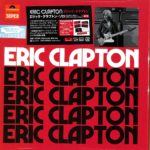As comprehensive as this 50th anniversary, four-disc set is, collecting three separate mixes of Eric Clapton’s eponymous debut solo album issued in the spring of 1970, as well as a variety of alternate versions, it also represents what an ineffaceable impact Delaney Bramlett had on the major forces in rock music during that monumental year. One half of a husband-wife duo, with partner Bonnie, leading a Southern-flavored ensemble of “Friends,” Bramlett and/or members of his group were showing up just about everywhere there was some great music being made.
Bassist Carl Radle and drummer Jim Gordon, part of Delaney and Bonnie’s integral rhythm section, were a key component of the Leon Russell-led group backing Joe Cocker on the iconic Mad Dogs and Englishmen. So, too, were Radle and Gordon, joined by Friends keyboardist and songwriter Bobby Whitlock, in the outfit that tracked George Harrison’s epic All Things Must Pass. Now, the Radle/Gordon/Whitlock trio (and Russell, too) were recruited by Clapton (with Delaney producing) to cut the guitarist’s debut.
Clapton was in transition, fresh off of touring Europe with D&B and Friends, and simultaneously enamored with The Band’s Music from Big Pink. His time with electric British Blues superstars like John Mayall and Cream had exhausted itself. Not only was he devotedly following this new muse of American roots, he was also changing guitars- adopting the cleaner, cutting Fender Strat as his go-to in place of the hefty crunch of his Gibson.
All of this, plus Clapton’s initial foray into the role of lead vocalist, totaled an album that displays EC as much a student as a developing master. As such, his voice is, at times, indistinguishable from Delaney’s (who does sing backgrounds), borrowing generously from his tutor in style and intonation. And his contributions as a writer are more often in collaboration with Bonnie than singular visions. He’s also learning to harness the glassier tone of the Strat, slicing through with sporadic, jagged bursts, rather than dominating with distortion-laden showcases of length and volume that his previous efforts flaunted.
What the three unique mixes of the complete album convey- with Clapton’s own attempt, he admits, the least effective- is that this was very pliable and evolving material; Dowd’s mix, the most commercially friendly; Delaney’s, a more soulful, ensemble-driven approach; Clapton’s, spacey and somewhat dated. Ultimately, the label chose Dowd’s version. And, ultimately, Clapton chose to pursue this collaboration with a giant step further; a few months later, Radle, Gordon, and Whitlock would team with Clapton and Duane Allman in Miami as Derek and the Dominos for the Dowd-produced masterpiece, Layla and Other Assorted Love Songs.
On the disc of alternate takes, there is a rendition of “Let It Rain” titled “She Rides.” It’s the same backing track of music, but with different lyrics and a slightly different vocal melody; much more ‘60s flower than ‘70s power. Eric Clapton is, in hindsight, a somewhat liminal album, especially in Layla’s shadow, but vitally important as a bridge, exemplified by the metamorphosis of “She Rides” to “Let It Rain.” A bridge Delaney Bramlett lit for quite a few legends in 1970.



No Comments comments associated with this post